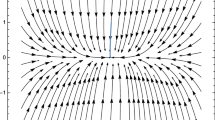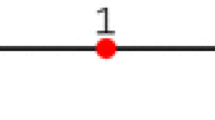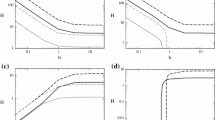Abstract
The Szekeres system with cosmological constant term describes the evolution of the kinematic quantities for Einstein field equations in \({\mathbb {R}}^4\). In this study, we investigate the behavior of trajectories in the presence of cosmological constant. It has been shown that the Szekeres system is a Hamiltonian dynamical system. It admits at least two conservation laws, h and \(I_{0}\) which indicate the integrability of the Hamiltonian system. We solve the Hamilton–Jacobi equation, and we reduce the Szekeres system from \({\mathbb {R}}^4\) to an equivalent system defined in \({\mathbb {R}}^2\). Global dynamics are studied where we find that there exists an attractor in the finite regime only for positive valued cosmological constant and \(I_0<-2 .08\). Otherwise, trajectories reach infinity. For \(I_ {0}>0\) the origin of trajectories in \({\mathbb {R}}^2\) is also at infinity. Finally, we investigate the evolution of physical properties by using dimensionless variables different from that of Hubble-normalization conducing to a dynamical system in \({\mathbb {R}}^5\). We see that the attractor at the finite regime in \({\mathbb {R}}^5\) is related with the de Sitter universe for a positive cosmological constant.



















Similar content being viewed by others
References
A. Krasiński, Inhomogeneous Cosmological Models (Cambridge University Press, Cambridge, 1997)
R. Maartens, W. Lesame, G.F.R. Ellis, Consistency of dust solutions with div H = 0. Phys. Rev. D 55, 5219 (1997). https://doi.org/10.1103/PhysRevD.55.5219
P. Szekeres, A class of inhomogeneous cosmological models. Commun. Math. Phys. 41, 55 (1975). https://doi.org/10.1007/BF01608547
J.D. Barrow, J. Stein-Schabes, Inhomogeneous cosmologies with cosmological constant. Phys. Lett. A 103, 315 (1984). https://doi.org/10.1016/0375-9601(84)90467-5
G.M. Covarrubias, A class of Szekeres space-times with cosmological constant. Astroph. Sp. Sci. 103, 401 (1984). https://doi.org/10.1007/BF00653757
M. Bruni, S. Matarrese, P. Ornella, Dynamics of silent universes. Astroph. J. 445, 958 (1995). https://doi.org/10.1086/175755
D.A. Szafron, Inhomogeneous cosmologies: new exact solutions and their evolution. J. Math. Phys. 18, 1673 (1977). https://doi.org/10.1063/1.523468
S.W. Goode, J. Wainwright, Characterization of locally rotationally symmetric space-times. Gen. Relativ. Gravit. 18, 315 (1986). https://doi.org/10.1007/BF00765890
J.A.S. Lima, J. Tiommo, Inhomogeneous two-fluid cosmologies. Gen. Relat. Gravit. 20, 1019 (1988). https://doi.org/10.1007/BF00759023
K. Bolejko, M.-N. Célérier, A. Krasiński, Inhomogeneous cosmological models: exact solutions and their applications. Class. Quantum Grav. 28, 164002 (2011). https://doi.org/10.1088/0264-9381/28/16/164002
C. Saulder, S. Mieske, E. van Kampen, W.W. Zeilinger, Hubble flow variations as a test for inhomogeneous cosmology. A&A 622, A83 (2019). https://doi.org/10.1051/0004-6361/201629174
C. Clarkson, M. Regis, The cosmic microwave background in an inhomogeneous universe. JCAP 02, 013 (2011). https://doi.org/10.1088/1475-7516/2011/02/013
K. Bolejko, The Szekeres Swiss Cheese model and the CMB observations. Gen. Rel. Gravit. 41, 1737 (2009). https://doi.org/10.1007/s10714-008-0746-x
K. Bolejko, M. Korzyński, Inhomogeneous cosmology and backreaction: Current status and future prospects. IJMPD 26, 1730011 (2017). https://doi.org/10.1142/S0218271817300117
K. Bolejko, M.-N. Célérier, Szekeres Swiss-cheese model and supernova observations. Phys. Rev. D 82, 103510 (2010). https://doi.org/10.1103/PhysRevD.82.103510
M. Ishak, A. Peel, Growth of structure in the Szekeres class-II inhomogeneous cosmological models and the matter-dominated era. Phys. Rev. D 85, 083502 (2012). https://doi.org/10.1103/PhysRevD.85.083502
D. Vrba, O. Svitek, Modelling inhomogeneity in Szekeres spacetime. Gen. Relativ. Grav. 46, 1808 (2014). https://doi.org/10.1007/s10714-014-1808-x
A. Gierzkiewicz, Z.A. Golda, On integrability of the Szekeres system, I. J. Nonlinear Math. Phys. 23, 494 (2016). https://doi.org/10.1080/14029251.2016.1237199
A. Gierzkiewicz, Z.A. Golda, A complete set of integrals and solutions to the Szekeres system. Phys. Lett. A 382, 2085 (2018). https://doi.org/10.1016/j.physleta.2018.05.038
A. Paliathanasis, P.G.L. Leach, Symmetries and Singularities of the Szekeres System. Phys. Lett. A 381, 1277 (2017). https://doi.org/10.1016/j.physleta.2017.02.009
A. Ramani, B. Dorizzi, B. Grammaticos, T. Bountis, Integrability and the Painlevé property for low-dimensional systems. J. Math. Phys. 25, 878 (1984). https://doi.org/10.1063/1.526240
A. Paliathanasis, A. Zampeli, T. Christodoulakis, M.T. Mustafa, Quantization of the Szekeres system. Class. Quantum Grav. 35, 125005 (2018). https://doi.org/10.1088/1361-6382/aac227
P.G.L. Leach, Lie symmetries and Noether symmetries. Applic. Anal. Discrete Math. 6, 238–246 (2012)
A. Paliathanasis, Quantum potentiality in inhomogeneous cosmology. Universe 7, 52 (2021). https://doi.org/10.3390/universe7030052
A. Zampeli, A. Paliathanasis, Quantization of inhomogeneous spacetimes with cosmological constant term. Class. Quantum Grav. 38, 165012 (2021). https://doi.org/10.1088/1361-6382/ac1209
J. Libre, C. Valls, On the dynamics of the Szekeres system. Phys. Lett. A 383, 301 (2019). https://doi.org/10.1016/j.physleta.2018.10.050
J. Libre, C. Valls, Dynamics of the Szekeres system. J. Math. Phys. 62, 082502 (2021). https://doi.org/10.1063/5.0054051
E.J. Copeland, A.R. Liddle, D. Wands, Exponential potentials and cosmological scaling solutions. Phys. Rev. D 57, 4686 (1998). https://doi.org/10.1103/PhysRevD.57.4686
A.A. Coley, R.J. van den Hoogen, The dynamics of multiscalar field cosmological models and assisted inflation. Phys. Rev. D (2000). https://doi.org/10.1103/PhysRevD.62.023517
A.P. Billyard, A.A. Coley, J.E. Lidsey, U.S. Nilsson, Dynamics of M theory cosmology. Phys. Rev. D 61, 043504 (2000). https://doi.org/10.1103/PhysRevD.61.043504
A.A. Coley, Dynamical systems and cosmology. Astroph. Space Sci. Libr. (2003). https://doi.org/10.1007/978-94-017-0327-7
G. Leon, E.N. Saridakis, Dynamical analysis of generalized Galileon cosmology. JCAP 03, 025 (2013). https://doi.org/10.1088/1475-7516/2013/03/025
G.A. Rave-Franco, C. Escamilla-Rivera, J.L. Said, Dynamical complexity of the teleparallel gravity cosmology. Phys. Rev. D 103, 084017 (2021). https://doi.org/10.1103/PhysRevD.103.084017
R.G. Landim, Cosmological perturbations and dynamical analysis for interacting quintessence. EPJC 79, 889 (2019). https://doi.org/10.1140/epjc/s10052-019-7418-8
M. Karčiauskas, Dynamical Analysis of Anisotropic Inflation. Mod. Phys. Lett. A 31, 1640002 (2016). https://doi.org/10.1142/S0217732316400022
G. Leon, E.N. Saridakis, Dynamical behavior in mimetic F(R) gravity. JCAP 04, 031 (2015). https://doi.org/10.1088/1475-7516/2015/04/031
A. Suroso, F.P. Zen, Cosmological model with nonminimal derivative coupling of scalar fields in five dimensions. Gen. Rel. Gravit. 45, 799 (2013). https://doi.org/10.1007/s10714-013-1500-6
A. Paliathanasis, G. Leon, Asymptotic behavior of N-fields Chiral Cosmology. EPJC 80, 847 (2020). https://doi.org/10.1140/epjc/s10052-020-8423-7
A. Giacomini, S. Jamal, G. Leon, A. Paliathanasis, J. Saavedra, Phys. Rev. D 95, 124060 (2017). https://doi.org/10.1103/PhysRevD.95.064031
B. Aulbach, Continuous and Discrete Dynamics near Manifolds of Equilibria. Lecture Notes in Mathematics No. 1058, Springer (1984)
Guckenheimer, J., Holmes, P.: Nonlinear Oscillations, Dynamical Systems, and Bifurcations of Vector Fields, Applied Mathematical Sciences, vol. 42 (Springer, Berlin, New York, 1997). 978-0-387-90819-9, corrected fifth printing
G. Iooss, M. Adelmeyer, Topics in Bifurcation Theory. p. 7 (1992)
J. Llibre, C. Valls, Phys. Dark Univ. 35, 100954 (2022). https://doi.org/10.1016/j.dark.2022.100954
Acknowledgements
This research was funded by Agencia Nacional de Investigación y Desarrollo—ANID through the program FONDECYT Iniciación grant no. 11180126 and by Vicerrectoría de Investigación y Desarrollo Tecnológico at Universidad Católica del Norte. Ellen de Los Milagros Fernández Flores is acknowledged for proofreading this manuscript and for improving the English.
Author information
Authors and Affiliations
Corresponding author
Appendix A: Szekeres system with \(\Lambda =0\)
Appendix A: Szekeres system with \(\Lambda =0\)
Phase-space portraits for Szekeres associated to system (A1), (A2) for different values of the free parameters \(I_{0}\) and h and zero value for the cosmological constant, i.e. \(\Lambda =0\). Figures of the first row are in the local variables \(\left( x,y\right) \), while figures of the second row are for the compactified variables \(\left( X,Y\right) \)
In this “Appendix” we discuss about the global dynamics for Szekeres system with \(\Lambda =0\). Such analysis has been published before for other set of variables in [26]. However, for the completeness of our analysis we summarize the main results in the following lines. The dynamical system (57), (58) for \(\Lambda =0\) reads
The latter dynamical system in the finite regime admits the stationary points \(P_{0}^{\left( \Lambda =0\right) }=\left( 0,0\right) \) and \(P_{1}^{\left( \Lambda =0\right) }=\left( \frac{4h}{I_{0}^{2}},-\frac{2}{I_{0}}\right) \) which exist for \(I_{0}\ne 0\) and it is physically accepted when \(I_{0}<0,\) because \(y\ge 0.\) The eigenvalues of the linearized system around point \(P_{0}^{\left( \Lambda =0\right) }\) are \(-6\sqrt{3}\) and \(3\sqrt{3}\), which means that the point is saddle. Similarly, for point \(P_{1}^{\left( \Lambda =0\right) }\) we derive the eigenvalues \(6\sqrt{3}\) and \(3\sqrt{3}\) which means that \(P_{1}^{\left( \Lambda =0\right) }\) is a source. Thus, do not exists stationary point at the finite regime. As far as the analysis at infinity is concerned, we can easily conclude from the results of Sect. 4 that results for \(\Lambda <0\) and \(I_{0}<0\) apply also when \(\Lambda =0\) and \(I_{0}<0\). Therefore, the trajectories can end at infinity, while they are originated at infinity or the source point \(P_{1}^{\left( \Lambda =0\right) }\).
In Fig. 20 phase-space portraits for the Szekeres system with zero cosmological constant terms for different values of the free variables are presented. We observe that the trajectories of the dynamical systems end at infinity.
Rights and permissions
About this article
Cite this article
Paliathanasis, A., Leon, G. Global dynamics and evolution for the Szekeres system with nonzero cosmological constant term. Eur. Phys. J. Plus 137, 366 (2022). https://doi.org/10.1140/epjp/s13360-022-02542-9
Received:
Accepted:
Published:
DOI: https://doi.org/10.1140/epjp/s13360-022-02542-9





